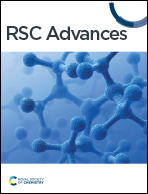Nanostructured IrOx supported on N-doped TiO2 as an efficient electrocatalyst towards acidic oxygen evolution reaction†
Abstract
Reducing the Ir consumption without compromising the catalytic performance for the oxygen evolution reaction (OER) is highly paramount to promote the extensive development of the environmentally-friendly solid polymer electrolyte water electrolysis (SPEWE) system. Herein, TiO2 is doped with N through facile NH3 gas treatment and innovatively employed to support IrOx nanoparticles towards acidic OER. N-doping action not only dramatically boosts the electrical conductivity and dispersing/anchoring effects of TiO2, but also effectively improves the electron-transfer procedure. As a result, the IrOx/N–TiO2 electrocatalyst exhibits prominent catalyst utilization, catalytic activity and stability. Specifically, the overpotential required to deliver 10 mA cm−2 is only 270 mV, and the mass activity climbs to 278.7 A gIr−1 @ 1.55 VRHE. Moreover, the single cell voltage is only 1.761 V @ 2.0 A cm−2 when adopting IrOx/N–TiO2 as the anode catalyst, which is 44 mV lower than that of the commercial IrO2 counterpart.



 Please wait while we load your content...
Please wait while we load your content...